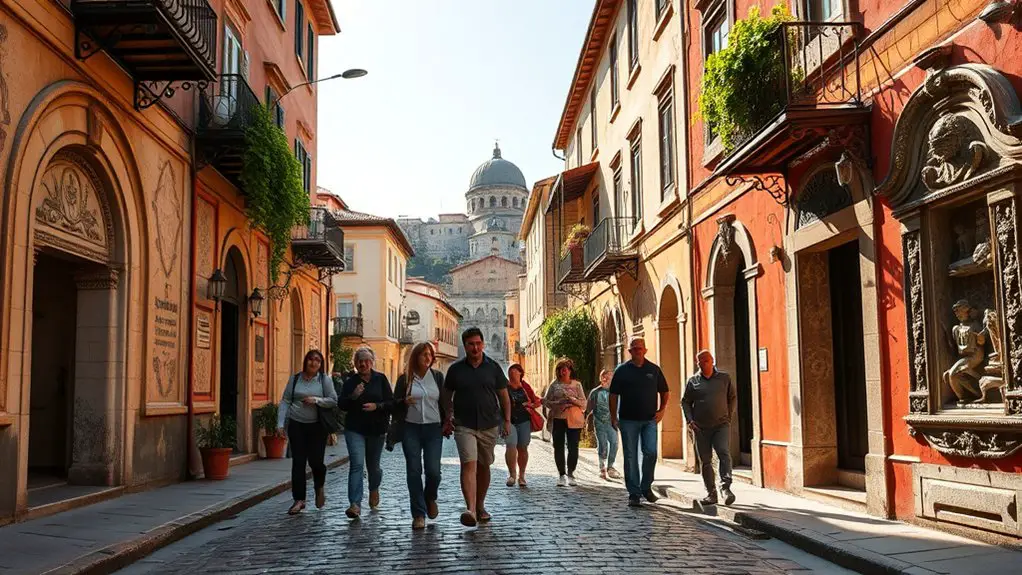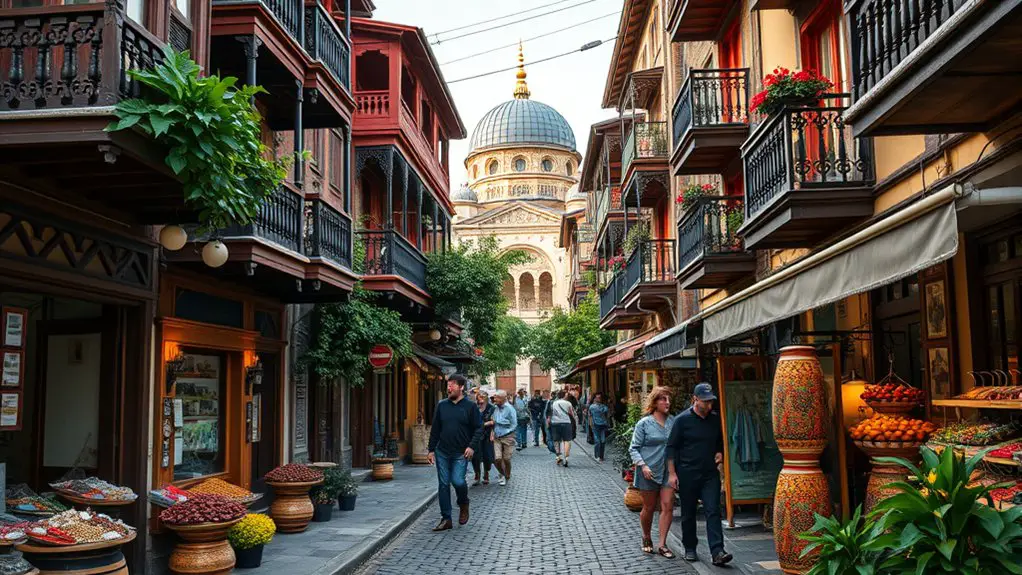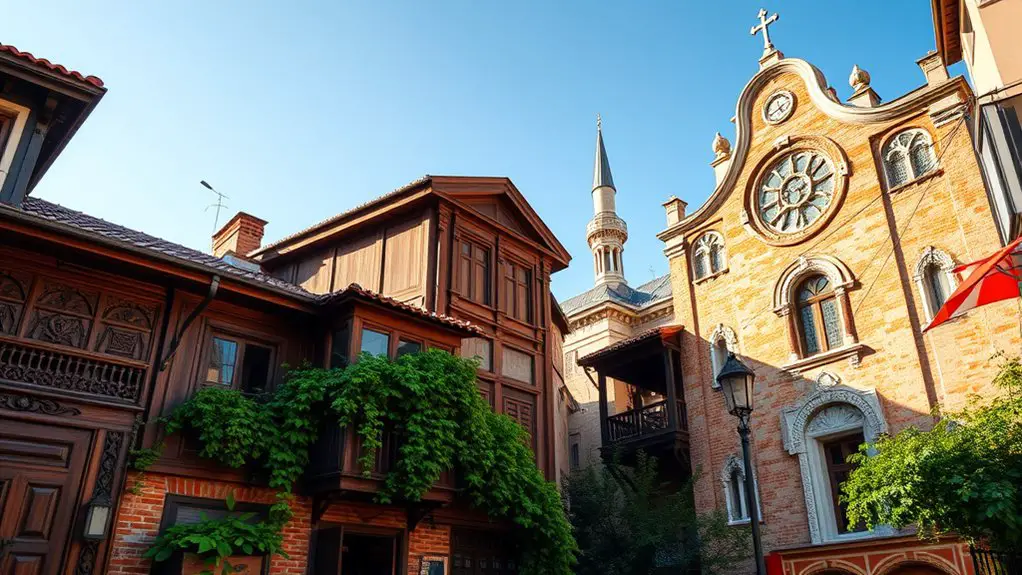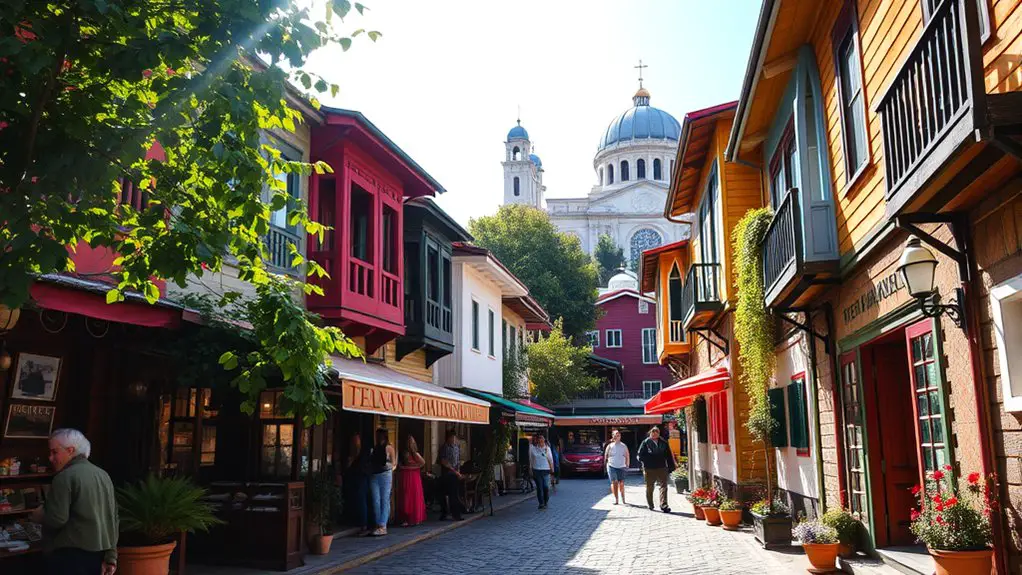Fener’s history begins in Byzantine times, serving as a strategic outpost with churches and fortifications reflecting its religious and military significance. During the Ottoman era, it transformed with new architecture, becoming a hub for religious and political power, particularly with structures like the Patriarchate. Today, efforts preserve its layered heritage through restoration and community engagement. If you stay curious, you’ll uncover the fascinating stories behind its iconic landmarks and vibrant cultural evolution.
Key Takeaways
- Fener originated as a Byzantine outpost with significant religious and military structures, including churches and fortifications.
- During the Ottoman era, Fener evolved with distinctive Ottoman architecture, becoming a center for religious and administrative authority.
- The Greek Orthodox Patriarchate in Fener symbolizes religious resilience and blends Byzantine and Ottoman architectural influences.
- Fener’s historic sites reflect centuries of religious diversity, including churches and mosques, showcasing layers of cultural interchange.
- Modern preservation efforts focus on restoring landmarks and engaging communities to maintain Fener’s rich historical and cultural heritage.
The Origins of Fener in Byzantine Times

Fener’s origins trace back to the Byzantine era, when it was established as a strategic outpost overlooking the Golden Horn. During this period, the area became significant for its defensive position and trade routes.
Byzantine architecture shaped the early structures, with churches and fortifications built to secure the region. The Fener history reveals that it served both religious and military purposes, reflecting Byzantine priorities in urban planning.
As Fener developed, it became a hub for religious activity, highlighted by the construction of notable Byzantine churches. These structures feature characteristic elements such as domes, mosaics, and brickwork, which exemplify Byzantine architecture’s craftsmanship.
Over time, Fener’s strategic importance grew, making it an essential part of Constantinople’s defenses. This early history sets the foundation for understanding Fener’s transformation in later periods.
Recognizing its origins helps you appreciate the layered historical and architectural significance that continues to define Fener today.
Fener During the Ottoman Empire

As the Byzantine Empire declined and the Ottoman Turks rose to prominence, Fener underwent significant changes that reflected the shifting political and cultural landscape of Istanbul.
During the Ottoman period, the neighborhood experienced a transformation in its urban fabric, marked by the development of distinctive Ottoman architecture. Many Byzantine structures were replaced or adapted, blending traditional Islamic design with local influences.
Fener’s urban landscape evolved through Ottoman architecture, blending Islamic design with local influences and replacing Byzantine structures.
Fener became a hub for the Ottoman administrative and religious elite, reinforcing a strict social hierarchy. The area’s prominent structures, such as the Patriarchate, exemplify the Ottoman’s use of architecture to assert authority and religious identity.
Social stratification was evident in the neighborhood’s layout, with the residences of high-ranking officials and clergy located near key institutions.
Over time, Fener’s Ottoman era solidified its role as a center of religious and political power, shaping its urban character and social structure well into the later centuries.
Architectural Landmarks and Their Significance

Among Fener’s many architectural landmarks, the Greek Orthodox Patriarchate stands out as a symbol of religious authority and historical resilience.
Built in the late Byzantine period, its architecture reflects a blend of Byzantine and Ottoman influences, showcasing intricate domes, arches, and detailed facades. Over the centuries, the structure has undergone renovations, but efforts at historical preservation have maintained its original architectural styles, emphasizing its cultural importance.
You’ll notice how the building’s design encapsulates the shift from Byzantine grandeur to Ottoman practicality, illustrating its layered history. The preservation of these features is vital, as they embody Fener’s rich past and religious significance.
Religious Diversity and Heritage
As you walk through Fener, you’ll notice how its religious sites reflect a rich history of cultural interchange, starting with the Byzantine church that later became a mosque.
These sites exemplify the layers of faith that have shaped the neighborhood over centuries, illustrating both spiritual significance and evolving architectural styles.
Observing the blending of religious traditions reveals a unique tapestry of cultural syncretism that defines Fener’s heritage.
Religious Sites Significance
Fener’s religious sites embody a rich tapestry of spiritual heritage that reflects its historical role as a crossroads of faiths. The Byzantine period saw the construction of the monumental Fener Greek Orthodox Patriarchate, establishing it as a center for religious leadership and pilgrimages.
During Ottoman rule, the site retained its sacred significance, hosting mosques like the Balat Mosque, which incorporated Byzantine elements, symbolizing religious continuity. These sites have long been focal points for sacred traditions and religious pilgrimages, attracting believers seeking spiritual connection.
Over centuries, Fener’s religious architecture evolved to accommodate diverse communities, emphasizing its importance as a multi-faith hub. This layered history underscores the enduring significance of Fener’s religious sites, serving as living monuments to its spiritual diversity and centuries-old sacred traditions.
Cultural Syncretism Display
Fener vividly exemplifies cultural syncretism through its layered religious heritage, where diverse traditions have intersected and influenced one another over centuries.
Initially, Byzantine Christianity shaped its early identity, evident in the historic churches and religious art. The Ottoman conquest introduced Islamic influences, leading to syncretic practices that blended Christian and Muslim elements, visible in architecture and communal rituals.
The transfer of religious sites, such as the conversion of Byzantine churches into mosques, highlights evolving cultural influences. Over time, these changes fostered a unique heritage reflecting multiple faiths.
Today, the coexistence of religious symbols and practices embodies this syncretic history, illustrating how Fener’s cultural influences have intertwined, creating a layered, multicultural tapestry.
This ongoing blending underscores the city’s rich, diverse heritage for visitors.
Fener’s Role in Istanbul’s Cultural Evolution
In the complex tapestry of Istanbul’s history, Fener has played a pivotal role in shaping the city’s cultural evolution. During the Byzantine era, it emerged as a center of religious and artistic influence, blending Eastern Christian traditions with local customs.
With the Ottoman conquest, Fener became a hub for cultural exchange, where Greek, Ottoman, and later European influences converged. The construction of the Patriarchate and the presence of foreign communities fostered artistic innovation, evident in architecture, liturgical art, and music.
Throughout the centuries, Fener’s vibrant interactions with diverse cultures propelled a dynamic exchange of ideas and artistic expressions, enriching Istanbul’s cultural landscape. This evolution reflects Fener’s significance as a melting pot of religious and cultural identities, continuously shaping the city’s identity.
Modern-Day Fener: Preserving History Amid Change
Today, Fener actively restores its historic landmarks to maintain their architectural integrity and cultural significance.
As the neighborhood evolves, it also embraces its diverse communities, blending different traditions and histories.
This balance of preservation and adaptation reflects Fener’s ongoing effort to honor its past while welcoming modern change.
Restoring Historical Landmarks
As urban development accelerates, efforts to restore Fener’s historic landmarks have become essential in maintaining its cultural integrity.
The process began in the early 2000s, focusing on identifying key sites needing urgent landmark preservation. Restoration projects prioritized structural stability while respecting original architecture, often involving meticulous historical restoration techniques.
Throughout the years, government initiatives and private collaborations introduced funding and expertise, leading to the successful revival of churches, mosques, and traditional facades.
These efforts aimed to balance modern demands with preservation, ensuring that Fener’s unique character endures. By systematically addressing deterioration and implementing sustainable practices, the city has safeguarded its heritage for future generations, transforming Fener into a living museum that honors its past while adapting to present-day urban growth.
Embracing Cultural Diversity
Despite the rapid modernization of Fener, the neighborhood actively preserves its rich cultural diversity by embracing its multifaceted history and community fabric.
Over the years, local residents and organizations have hosted cultural festivals celebrating its diverse heritage, from Greek Orthodox traditions to Turkish customs. These festivals, often held annually, foster intercultural dialogue and reinforce community bonds.
Additionally, community gatherings serve as platforms for residents to share stories, maintain language traditions, and honor religious practices. This ongoing engagement guarantees that old customs remain alive amid urban development.
Frequently Asked Questions
How Has Fener’s Demographic Composition Changed Over Centuries?
You observe that Fener’s demographic composition evolved through cultural shifts and population dynamics, with Greeks, Armenians, and Turks shaping its identity over centuries, reflecting changing political, social, and religious influences that continuously transformed its diverse community.
What Are Some Lesser-Known Historical Events That Took Place in Fener?
You’ll find that Fener’s lesser-known events include Byzantine influence’s resilience during Ottoman rule, such as the 17th-century religious debates and the 19th-century reforms, which reflect its layered history and ongoing Ottoman heritage shaping its identity.
How Do Local Residents Today Perceive Fener’s Historical Significance?
You’ll find locals today view Fener’s historical significance through cultural identity and pride, seeing its layered history as a foundation for community resilience, while embracing ongoing preservation efforts that reflect their deep connection to its past.
What Conservation Efforts Are Currently Underway to Preserve Fener’s Sites?
You’ll find that conservation strategies in Fener focus on heritage preservation through detailed restoration projects, community involvement, and stricter regulations, ensuring the area’s historical significance is maintained for future generations while adapting to modern urban needs.
Are There Any Unique Local Festivals or Traditions Specific to Fener?
Like a tapestry woven with history, Fener festivals celebrate its diverse heritage, from the colorful Fener Orthodox Festival to local traditions honoring saints, offering you a vivid glimpse into Fener’s unique cultural identity through lively, chronological events.
Conclusion
As you explore Fener’s rich history, remember that understanding its past reveals the soul of Istanbul itself. From Byzantine origins to Ottoman influences, each landmark and tradition tells a story of resilience and cultural exchange. Walking through Fener, you witness how history shapes present-day identity. As the saying goes, “A tree without roots is easily toppled.” Embrace Fener’s layered heritage, and you’ll gain a deeper appreciation for Istanbul’s enduring spirit.
